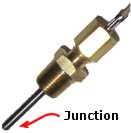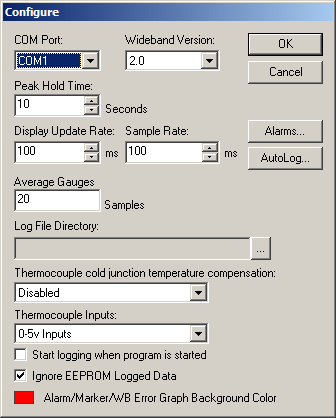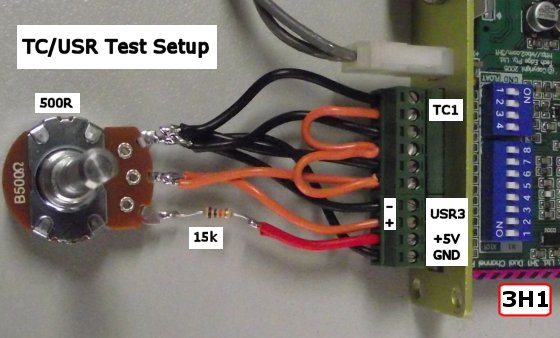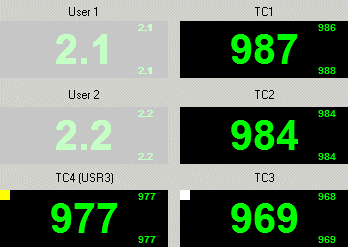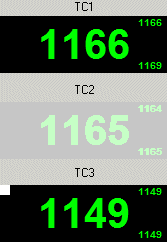TEWBlog with Four (or more) TCs

We are going to show you how to get a fourth working thermocouple channel on either 3B1 or 3H1 (see later for 3A/E and others).
These controllers have four differential channels TC1, TC2, TC3 & USR3 which are very suitable for thermocouples.
We will set up USR3 to be TC4 because USR3 can be easily and independently set to multiply its input by the x101 factor
required for correct thermocouple support.
Hardware setup: the image at left how the 8 way DIP switch inside the 3H1 case should be set for USR3 to become TC4 (the 3B1 is similar
and is shown here).
The DIP switch is set for x101 amplification (switches 1 and 2 in the ON position).
The x101 factor is required as noted in the technical section above.
Click on the image (or here) to see
the default position of the switches as shipped (USR3 by default is a 0-5 Volt input with a x1 amplification factor).
Configure Setup: Now we have the hardware set correctly, we have to set up the software.
Refer to the TEWBlog Configure dialogue box above right.
It shows we have set the Thermocouple Inputs to be 0-5v Inputs. We do this because, as we will see, we can then
use the same tables for TC and for USR inputs. We have also Disabled CJC (Cold Junction Compensation).
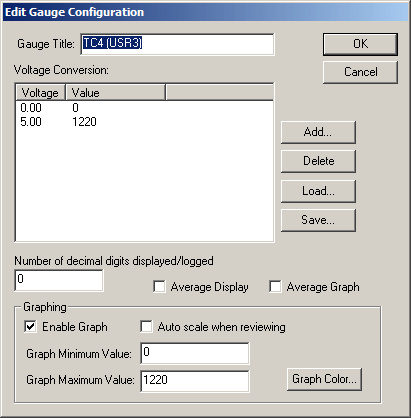
Each Channel's Setup: Now we have to set up each of the existing thermocouple
channels TC1 to TC3 as well as the new TC4 (ie. USR3) channel.
USR3/TC4: The image, immediate right, shows the setup for USR3 (we will rename it to be TC4).
To get to this screen from TEWBlog's main screen,
click on the User 3 display, this is in the centre column & is the third image from top
(image).
Here's what we have done:
- Changed the title to be TC4 (USR3) to indicate what we are doing.
- Changed the Voltage Conversion: table to have the two points shown.
- 0.00 Volts corresponds to 0 degrees and,
- 5.00 Volts corresponds to 1220 (this is degrees Celsius).
- Have checked Enable Graph and,
- set the Graph Minimum and the Graph Maximum to 0 and 1220 degrees respectively.
The configuration file for the above is [Save...]d here as tc4usr3-set0to5-asTC.txt.
The setup for TC1 to TC3 is different to the default setup for these channels.
It's possible to load a new configuration from a file using the [Load...] button.
The contents of the file we need to load is:
TC channels as 0-5v inputs
Version: 1.0
Gauge Name: TCx
Graph Min: 0
Graph Max: 1220
Floating Point: 0
Gauge Data:
0.00, 0
0.63, 1230
Here's the above file tc1to3-set0to5-asTC.txt,
or simply copy and paste the above text into your own file.
Now, to customise each of the files for TC1 to TC3, simply [Load...] the file
for each channel and change the Gauge Title: as appropriate.
Go here to see what the result is.
A little explanation is required here because of some peculiarities of TEWBlog.
We really wanted to enter the second data point as 0.62494 Volts with Display 1220.
The theoretical value 0.62494 Volts is the 49.5 mVolts from the thermocouple at 1220 °C
times the 101 multiplication factor divided by the scaling from 13 bits to 10 bits (÷ 8) so 0.0495 * 101 ÷ 8 = 0.62494 Volts ~= 0.625V).
The point 0.63 Volts at 1230 °C point is the closest
we could get because when we [Save...] and re[Load...]
the configuration file, the 0.62494 value gets rounded up to 0.63, so we adjusted 1220 (by 1220*.630/.62494) to
give a precise 1230.
Some Explanations: To get four thermocouples working with TEWBlog,
we had to make some simplifications that now require explanation.
We disabled CJC on TC1 to TC3 so we could change USR3 to TC4.
Disabling CJC only becomes an issue if your absolute thermocouple readings are very important
or you are trying to measure low (below 250°C) temperatures accurately with a thermocouple..
The majority of users will be comparing one sensor's readings with another,
so even if their absolute values are not spot on, the differences will tell you what's happening between sensors.
If you're trying to read a relatively low temperature (say coolant temperature)
with a k-type thermocouple then this is NOT the correct thermocouple type to use in this situation!
Most water temperature sensors are thermistors
(not thermocouples) that are connected to a regulated voltage source (5 Volts)
via a resistor - quite different to what we're doing here!
The reality is that the actual temperature the EGT sensor measures is very dependent on the sensors position
in and down the exhaust tube. Small changes between the shape and flow of exhaust ports will often mean that
the same sensor will not read exactly the same in different ports that otherwise seem to be set up the same way.
| 